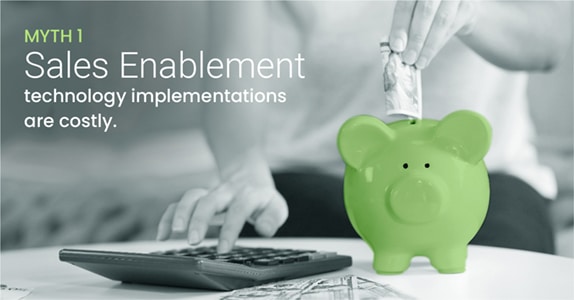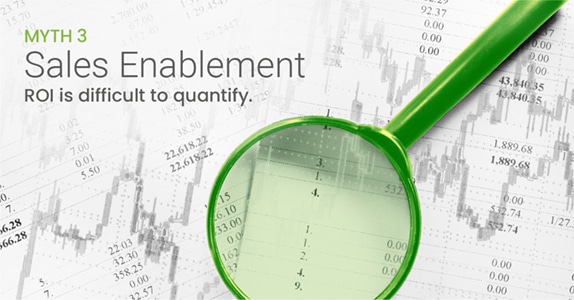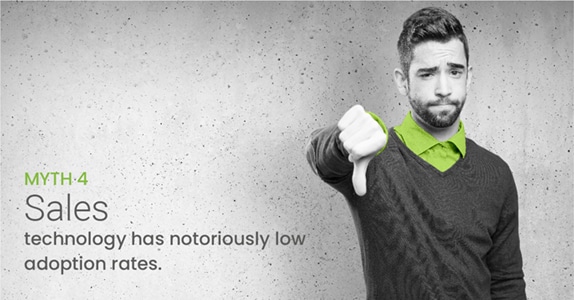In celebration of our recent acquisition of sales enablement provider iPresent Ltd., our fearless leader Carson Conant is taking over the blog for a three-week series on the importance of sales enablement, the misconceptions you shouldn’t buy into, and the reasons we at Mediafly believe in making sales enablement accessible for all sales teams, regardless of size, maturity or geography.
Google “sales enablement” and you’ll get 11,600,000 results, over five million of these on the benefits of sales enablement alone. Today, it’s no secret that implementing sales enablement can completely transform your business for increased revenue, shorter sales cycles, improved sales and marketing alignment, and better buyer engagement. But while 61% of companies today have added a dedicated sales enablement function, a lot fewer companies (less than 8%!) are deploying the technology needed to successfully support their initiatives (CSO Insights).
What’s holding them back?
Fear. There are a lot of misconceptions out there that paralyze buyers in the face of a sales enablement technology decision. But don’t believe everything you hear. In today’s blog, I’m debunking the most common (and most believed) myths about sales enablement technology.


Can sales enablement technology be costly? Yes. Does it have to be? Absolutely not. The key is to start small. Adopt a platform that makes it easy to make small, incremental changes and scale your solution in line with your success. Sales enablement is a journey, but to be successful you need to make it your own. Don’t adopt a pricy platform with bells and whistles just for the sake of checking boxes on an RFP. Select an affordable platform with the functionality you need to meet your goals today and the capacity to scale or add capabilities should your business grow or needs change. If you feel pressured to purchase capabilities that won’t have any impact on your unique business, you’re likely talking to the wrong provider. Find a solution and partner that can meet you where you are today and help you move as fast and far as you want to go on your individual sales enablement journey.

Sales enablement is still a relatively new concept and stakeholders are often hesitant to buy-in or approve budget without a clear understanding of the return on investment they’ll see. What happens if they commit to a platform, suffer through a horribly long and complicated deployment process, and then the whole thing fails? It’s their job on the line. But believe it or not, it is possible to get up and running with sales enablement tools and technology quickly and easily. In some cases, all you need is a monthly credit card subscription and a few hours to build a beautiful sales application that drives results.
Bonus: In many cases, adopting a platform that allows you to pay monthly by credit card also allows you to bypass that whole stakeholder approval thing to begin with.
Speaking of return on investment…

False. In fact, it’s actually very easy to quantify the ROI of sales enablement technology if you have the right platform. Sales enablement technology that allows you to effectively track, measure, and record content usage (by sellers) and content engagement (with buyers) offers invaluable insights into how your content impacts revenue. Using a platform that leverages machine learning and integrates with CRM, you can automatically log important meeting details like what content was presented and shared with customers and whether or not that content resonated with buyers. Understanding what works (and what doesn’t) empowers you to duplicate successful sales strategies for more deals won and make sure your valuable marketing dollars don’t go to waste. The right sales enablement platform will do more than increase sales efficiency. It will also measurably increase sales and marketing effectiveness and help you grow revenue – not vanity metrics like downloads or views.

Most companies evaluating sales enablement technology are doing so for the very first time. With nothing to compare a sales enablement technology implementation to, they often turn to their experience deploying other sales tech – most commonly, CRM – to level-set expectations. And according to Forrester Research, 49% of CRM projects fail. The biggest reason is low adoption. So why would sellers use sales enablement if they don’t use CRM? Because CRM wasn’t built with the seller in mind. It was designed as a tool for management to keep track of new revenue and pipeline generation across the sales team. For sellers, CRM is a time suck that takes them away from their single most important job: selling. Sales enablement technology, on the other hand, was built with the seller in mind. It empowers them to both easily prepare for sales meetings and lead more effective sales interactions in real-time with customers. What salesperson wouldn’t want to use a tool that was designed specifically to help them easily meet or even exceed their sales quota?
Bonus: If you integrate your sales enablement platform with CRM, you can not only drive sales enablement adoption across the organization but also increase CRM adoption by default (refer back to #3 for details).
Don’t believe the myths. Sales enablement is nothing to be feared. You can get started easily and inexpensively (today!), all the while maximizing your return on investment. And we can help.
Join our webinar 4 Reasons Sales Enablement Technology Scares The Hell Out Of People (And Proof They’re Way Off Base) to learn more.

Comments are closed.